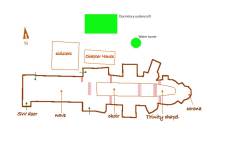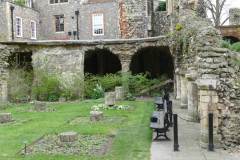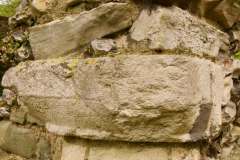Basics
Geology: Oolitic / pelletal limestone
Age: Jurassic
Provenance: Marquise, Pas-de-Calais department
Where to see examples
Some of the capitals, columns and bases in the undercroft of the great dormitory are Marquise Stone and Lanfranc’s cathedral is known to have used the stone in the floor paving of the nave. The stone can also be found in the ruined fabric of St. Augustine’s Abbey, Canterbury. St. Mildred’s Church in Canterbury has a particularly large block of Marquise Stone in the southwest corner of the nave. During the re-building of the east end of the cathedral, blocks of Marquise stone were re-used in the Trinity Chapel and the Corona. The Reculver columns in the south aisle of the cathedral crypt are of Marquise Stone.
surviving column caps in the dormitory undercroft (images 1-3 below)
Reculver columns (now in crypt)
Description
Marquise Stone was introduced to England by the Romans and greater quantities were shipped to Canterbury during the twelfth century. The stone outcrops inland of Boulogne and is of a comparable age to Caen Stone. The quarries were situated within easy reach of the English Channel, a short barge–ride down the River Slack from Marquise to Ambleteuse on the French coast. From the continental coast the stone was transported across the English Channel to Canterbury’s port at Fordwich.
Much of the stone shipped to Canterbury contains numerous irregular pellets of lime mud, some of which are faecal in origin. The stone is usually described as oolitic and small rounded grains of chemically precipitated calcium carbonate (ooliths) can often be seen with the aid of a hand lens. Their presence indicates deposition in a warm, shallow sea; much like those around the present day Bahamas. The stone is pale-cream to white in colour and can have a fine to coarse-grained texture depending on the quantity of carbonate mud pellets and occasional shell fragments. Samples of Marquise Stone can differ significantly in appearance indicating subtle differences in the environment of deposition.
Click on images to enlarge and read captions.
Only partial ruins remain of the dormitory undercroft of Christ Church Priory. To find them walk via the main cloister towards the water tower. Turn left before the water tower and you will be facing the undercroft. The marquise example shown above can be found in the row of columns on the right hand side of the overview image.



